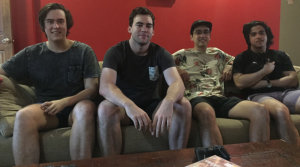The first in our ‘Indie Interview’ series where we take a break from developing The Flawless: Art’s Tale to have a chat with someone interesting in the indie game industry. This time we caught up with Gareth Ffoulkes, one of the team behind One Dreamer (read our blog post about One Dreamer here): A psychological, pixel-art game about an indie developer called Frank transitioning between a dream world and the waking world as he tries to get inspiration for his next indie game. Check out the complete interview below.
Q1: For the people who don’t know, tell us a little about yourself, your team, and your game.
We are a small independent team of four friends aged from 19 to 25 living in Darwin, Australia. One Dreamer is our first major title, with the main idea thought up while we were still teens in school.

Meet the One Dreamer team – (left-right) Dylan Teitaman, Sam Pile, Ben Quinn, & Gareth Ffoulkes.
Q2: What made you want to make indie games?
Our generation grew up with video games which had a huge impact on all of us. Games were always the topic of choice in the school yard and there was always a new release to look forward to. As the popularity of Indie games increased we realised that you don’t need to be part of a large company to create good games. I personally believe indie games are the ultimate storytelling platform, which is what makes me want to create them.
Q3: Can you tell us about the creative process behind One Dreamer, and how you got from the basic idea to the current demo?
Surprisingly the story is much harder to work on than anything else. I can’t just sit down and work on the story without feeling completely drained of creativity. The basic premise of the demo and game were thought up in bits and pieces, starting before I was even working on the project. It’s a personal story containing plot ideas from every team member.
Q4: What challenges have you faced in your indie game journey so far?
Our biggest challenge has been funding. Being such a personal dream of ours we decided we wouldn’t launch unless its the best work we can produce. That however puts a strain on our budget when purchasing quality equipment. Without a publisher its much harder to secure funding, but being independent allows us to create whatever we want without restrictions!
Q5: On your website you say that One Dreamer is inspired by games like Catherine and The Last of Us. Can you tell us a little bit more about how you’ve merged these very different styles of gameplay?
I love Catherine’s unique mix of vastly different gameplay and multiple story endings. That’s why One Dreamer has two very different gameplay modes separating reality (awake) and dream (asleep) states. The Last of Us uses interactive cinematics very well which we wanted to bring to pixel form along with its inspiring soundtrack. Both of them are heavily story orientated which is another one of One Dreamers major driving force.

The different states of One Dreamer – (left to right) dream/sleep state, awake state.
Q6: What advice or tips do you have for any aspiring indie developers dreaming of making their first game?
Pick up a free version of your preferred game engine (Unity and Unreal Engine 4 are great) and start learning. They are both very well documented and there are countless resources online to help you. As Shia LaBeouf would say, “JUST DO IT!”
Some really interesting insights there about the amazing looking game One Dreamer and the world of indie development in general. If you like the look of One Dreamer why not check out the free demo or follow its progress on Kickstarter or Twitter. Until next time we’re off back to our world of cats, code and pixels. You can keep up to date with all our games on Twitter, Facebook, Instagram, and Google+.

Tony Leavy is a director and writer at Bare Knuckle Development. When Tony isn’t writing plots for BKD games or articles for our blog she can be found travelling the world taking amazing photographs. She is also passionate about education and using video games to make education more inclusive and a more motivating experience.

